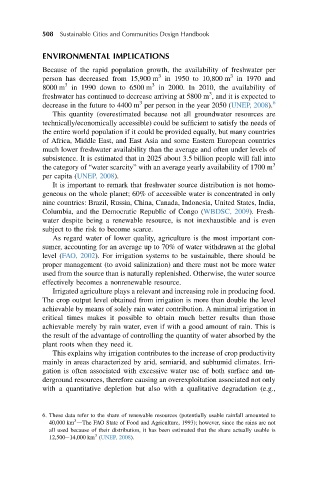Page 539 - Sustainable Cities and Communities Design Handbook
P. 539
508 Sustainable Cities and Communities Design Handbook
ENVIRONMENTAL IMPLICATIONS
Because of the rapid population growth, the availability of freshwater per
3
3
person has decreased from 15,900 m in 1950 to 10,800 m in 1970 and
3
3
8000 m in 1990 down to 6500 m in 2000. In 2010, the availability of
3
freshwater has continued to decrease arriving at 5800 m , and it is expected to
3
decrease in the future to 4400 m per person in the year 2050 (UNEP, 2008). 6
This quantity (overestimated because not all groundwater resources are
technically/economically accessible) could be sufficient to satisfy the needs of
the entire world population if it could be provided equally, but many countries
of Africa, Middle East, and East Asia and some Eastern European countries
much lower freshwater availability than the average and often under levels of
subsistence. It is estimated that in 2025 about 3.5 billion people will fall into
the category of “water scarcity” with an average yearly availability of 1700 m 3
per capita (UNEP, 2008).
It is important to remark that freshwater source distribution is not homo-
geneous on the whole planet; 60% of accessible water is concentrated in only
nine countries: Brazil, Russia, China, Canada, Indonesia, United States, India,
Columbia, and the Democratic Republic of Congo (WBDSC, 2009). Fresh-
water despite being a renewable resource, is not inexhaustible and is even
subject to the risk to become scarce.
As regard water of lower quality, agriculture is the most important con-
sumer, accounting for an average up to 70% of water withdrawn at the global
level (FAO, 2002). For irrigation systems to be sustainable, there should be
proper management (to avoid salinization) and there must not be more water
used from the source than is naturally replenished. Otherwise, the water source
effectively becomes a nonrenewable resource.
Irrigated agriculture plays a relevant and increasing role in producing food.
The crop output level obtained from irrigation is more than double the level
achievable by means of solely rain water contribution. A minimal irrigation in
critical times makes it possible to obtain much better results than those
achievable merely by rain water, even if with a good amount of rain. This is
the result of the advantage of controlling the quantity of water absorbed by the
plant roots when they need it.
This explains why irrigation contributes to the increase of crop productivity
mainly in areas characterized by arid, semiarid, and subhumid climates. Irri-
gation is often associated with excessive water use of both surface and un-
derground resources, therefore causing an overexploitation associated not only
with a quantitative depletion but also with a qualitative degradation (e.g.,
6. These data refer to the share of renewable resources (potentially usable rainfall amounted to
3
40,000 km dThe FAO State of Food and Agriculture, 1993); however, since the rains are not
all used because of their distribution, it has been estimated that the share actually usable is
3
12,500e14,000 km (UNEP, 2008).

